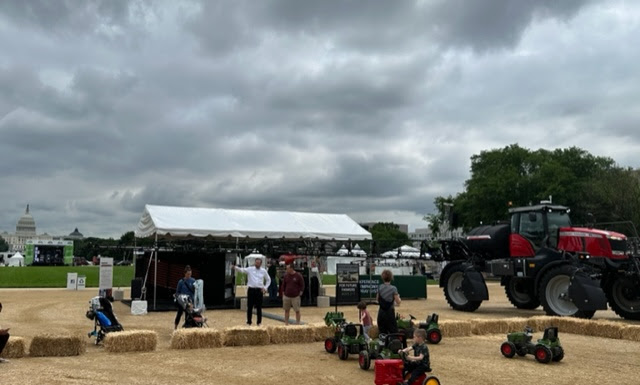As Republicans move forward with plans to vote on a farm bill, Democrats on the House Agriculture Committee have scheduled a meeting Thursday with House Minority Leader Hakeem Jeffries, D-N.Y., and Senate Ag Committee Chairwoman Debbie Stabenow, D-Mich.
Stabenow released a detailed summary of a draft farm bill that serves as a Democratic counter to the legislation House Ag Republicans are planning to push through committee on May 23.
A spokesman for House Ag Committee Democrats, Britton Burdick, says they remain “united on the importance of passing a bipartisan farm bill that invests in the farm safety net without making draconian cuts to SNAP.”
GOP take: “And to think people said we were crazy for thinking the retiring Senator was meddling in the affairs of the House...” – That was a post on X in which the House Ag majority staff responded to news of the Jeffries-Stabenow meeting.
CDC: Worker likely got avian flu from cow
New analysis from researchers at the Centers for Disease Control and Prevention and Texas health officials points to the likelihood that the Texas dairy worker who contracted avian flu was infected by a cow.
The worker’s job included exposure to “sick, presumably infected cows,” the CDC researchers said in their analysis of genetic sequences published by the New England Journal of Medicine.
“If cow-to-human transmission occurred, to our knowledge, this would be the first reported case” of transmission of H5N1 from a mammal to a human,” they said.
The experts say anecdotal reports of lower milk production among herds in Texas before confirmation of H5N1 in the state suggest that the virus may have been circulating undetected “for some unknown period of time leading to additional genetic diversity on affected farms.”
“Vigilance is needed because if [the virus] adapts and becomes established among cows or other mammals, the risk to public health may increase,” the experts say in supplementary materials.
 Deputy Ag Secretary Xochitl Torres Small addresses Modern Ag on the Mall.
Deputy Ag Secretary Xochitl Torres Small addresses Modern Ag on the Mall. Massey Ferguson precision sprayer.
Massey Ferguson precision sprayer. Joby Young, executive VP of the American Farm Bureau Federation, (right), with Agri-Pulse Associate Editor Rebekah Alvey (left) and Agri-Pulse Sales and Marketing Manager Jason Lutz (center) at Modern Ag on the National Mall on Monday
Joby Young, executive VP of the American Farm Bureau Federation, (right), with Agri-Pulse Associate Editor Rebekah Alvey (left) and Agri-Pulse Sales and Marketing Manager Jason Lutz (center) at Modern Ag on the National Mall on Monday Meatpacking giant Tyson Foods expects sales to be “relatively flat” in fiscal 2024 as inflation-challenged consumers look for bargains, company officials reported Monday.
Tyson, which has been struggling with some time with a tight cattle market, says chicken sales fell just short of offsetting a sales decline in its beef segment, which the company projects to lose $100 million to $400 million for the fiscal year that ends Sept. 30.
Cut through the clutter! We deliver the news you need to stay informed about farm, food and rural issues. Sign up for a FREE month of Agri-Pulse here.
“Uncertainties remain around consumer strength and behavior, the progression of the cattle cycle and key commodity costs,” Chief Financial Officer John Tyson told analysts.
World Bank outlines plan to reduce ag emissions
A new report from the World Bank says global greenhouse gas emissions could be reduced significantly by actions in the agriculture sector. But much of that work is going to have to happen in developing and middle-income countries, the report says.
Wealthy countries need to share low-emission practices and technologies with poorer nations, the report says. Middle-income countries, on the other hand, need to use their land more efficiently while reducing emissions from livestock and rice, improving soil health and reducing food loss and waste, the report says. Middle-income countries include China, Turkey, Russia, Brazil, Argentina, Nigeria, Angola, India and Pakistan.
Low-income countries, meanwhile, need to stop clearing forests for cropland, the report notes.
What does it cost? Annual investments in the sector need to increase by 18 times to $260 billion a year to cut ag emissions in half by 2030 and “put the world on-track for net-zero emissions by 2050,” the report says.
Much of the money could come from re-directing existing subsidies, the report says.
Estimates peg initial Texas wildfire damage at $123 million
More than 12,000 cattle died while wildfires blazed a 1.2 million-acre-path through the Texas panhandle this spring, causing an estimated $123 million in losses, according to preliminary estimates from Texas A&M University economists.
The fires killed $27 million worth of cattle while forcing ranchers to spend another $1 million in disposal costs and forced marketing losses, according to the preliminary estimates, which span from February through mid-March. Another $26 million in losses came from damaged pastures, while $68.7 million came from damage to fences, barns, corrals and other ranch infrastructure.
Several endangered heritage livestock breeds see turnaround
Fifteen at-risk historic livestock breeds have had their places shifted on an annual list gauging how close they are to extinction, and most of them saw improvements for the better, according to the Livestock Conservancy.
Hereford hogs and Southdown sheep exited the list this year, while Spanish goats, Tamworth pigs and Rhinelander rabbits have moved from the “Watch” category to “Recovering.”
Meishan pigs, a Chinese breed that was added to the list in 2018 after notable declines in their native country due to African swine fever regulations, have moved from “Critical” to “Threatened” amid a growing market for their pork.
Silver Fox Rabbits, Red Devon Cattle and Myotonic goats are “well on the path towards secure populations,” according to a summary of changes.
Take note: More than 180 breeds of livestock are on the 2024 list. Among these are the famous Texas longhorn cattle, which are listed under “critical” status.
She said it. “We should be able to support farmers in a way they feel like they have the best and brightest opportunities for their kids to take on this next generation of agriculture.” – Deputy Agriculture Secretary Xochitl Torres Small, speaking Monday at Modern Ag on the National Mall.




